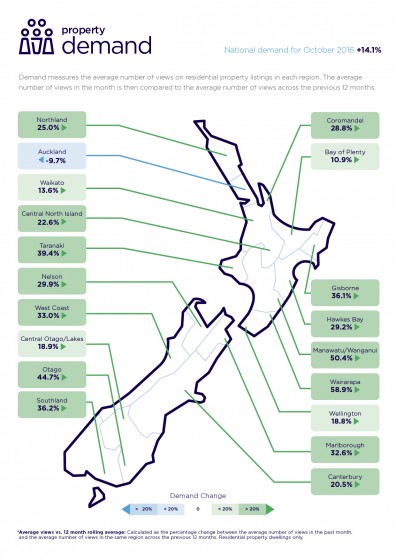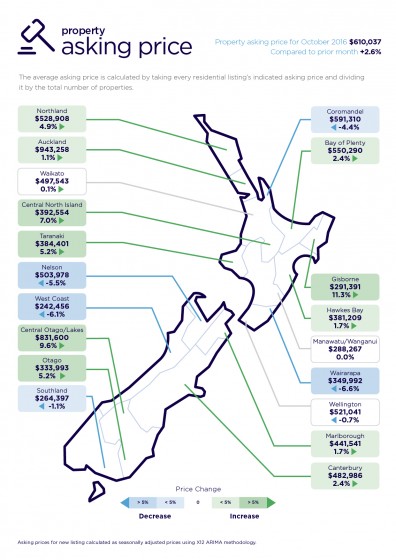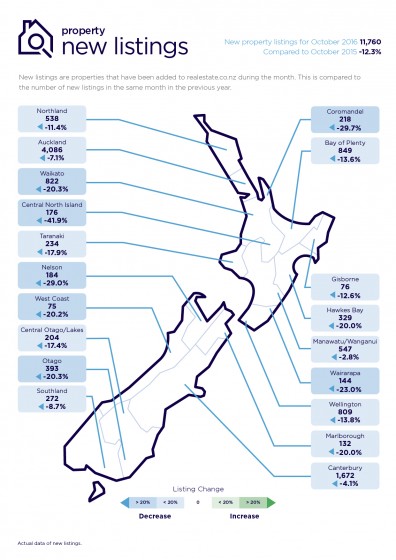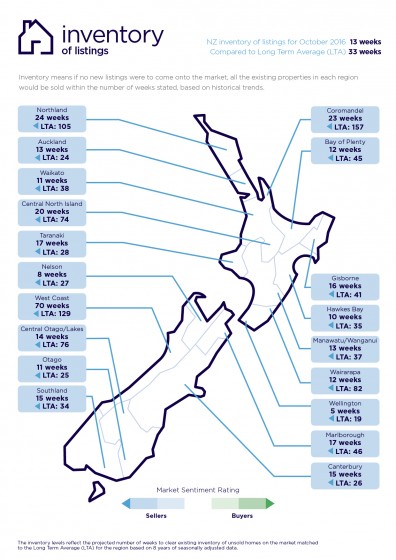Download the New Zealand property report in full.
The Manawatu-Wanganui region has hit the property sweet spot not only with locals, but with Aucklanders and Wellingtonians who are increasingly searching for property on realestate.co.nz. The search is most popular among those in the 25 – 44 year old age group.
Real time statistics from realestate.co.nz for the month ending October, show that demand (as measured by taking the number of listing views of residential properties on the site and comparing it with the average number of views over the previous 12 months*) is up 50.4 per cent in Manawatu-Wanganui. Over the same period, demand for property in Auckland has fallen by 9.7 per cent.

“Kiwis across the country aspire to own their own home and while most of the people searching in Manawatu-Wanganui are from the local area, 33.4 per cent more Aucklanders are also looking in the region (when compared with the same time last year) for the perfect match for their budget,” says realestate.co.nz CEO Brendon Skipper.
Wellingtonians are also keen on the Manawatu-Wanganui region, with a 53 per cent increase in site users viewing properties in this region when compared with the same month last year (October 2015).
Most of the attention in the region is on Palmerston North. The city has a long-term reputation as being one of the most affordable centres in New Zealand.

The average asking price for a home in Manawatu-Wanganui is $288,267, compared with Auckland which in the same month rose to another all-time high of $943,258.
Of the 19 regions across the country, there are only two regions (West Coast and Southland) where the average asking price is lower than Manawatu-Wanganui.
“It makes sense that Aucklanders would be looking at other regions and not only exploring investment options, but also weighing up the lifestyle benefits of a move outside of the big city,” says Brendon.
In addition to popular West Coast beaches, Manawatu-Wanganui is well located for visiting other regions. Wellington, Wairarapa, Wanganui, Taupo, Hawke’s Bay and the Ohakune ski fields are all within a three-hour drive.
In the October realestate.co.nz rental yield statistics, Manawatu-Wanganui is ranked the third best place to invest in a rental property. Investors would theoretically receive 5.3 per cent yield over a 12-month period – based on realestate.co.nz’s calculation of average asking price vs weekly rental price, excluding all external costs. Another solid reason to look at investing in Manawatu-Wanganui.
Auckland, the shine has dulled
Auckland was the only region across the country where the total number of residential dwellings for sale (inventory) was up, compared to October 2015. Total stock fell in all other regions across New Zealand. While Auckland was up slightly (1.4 per cent), nationally the total housing stock levels fell dramatically (by 24 per cent) when compared to the same month last year.
“Auckland asking prices continue to rise and as such, homes are spending longer on the market. Vendors continue to be focused on selling at a premium while buyers are being more considered and taking time to assess all of their options. With more stock on the market buyers aren’t feeling the same pressure they were 12 months ago,” says Brendon.
If no new listings were to come onto market in Auckland, all the existing properties would be sold in 12.5 weeks, compared to 9.3 weeks in May this year.

It’s not just global travellers who think Taranaki is a hot spot
“Big kudos to Taranaki for being named by the renowned ‘Lonely Planet Best in Travel Awards 2017’ as the second-best region in the world people should visit next year,” says Brendon Skipper.
“But it’s not just global travellers who have turned their attention to Taranaki,” he says.
New demand statistics generated by realestate.co.nz show that Aucklanders outnumber locals in terms of searching the region’s property offerings.
“It’s a hot destination and the market reflects its growing status,” says Brendon.
Taranaki property prices are now at an all-time high at $384,401, which is up 5.2 per cent on the previous month (September 2016).
There’s also a shortage of listings, down 28.1 per cent compared to October 2015.
“It’s a classic supply and demand situation,” says Brendon.

01 Nov 2016

